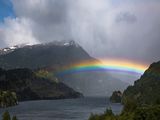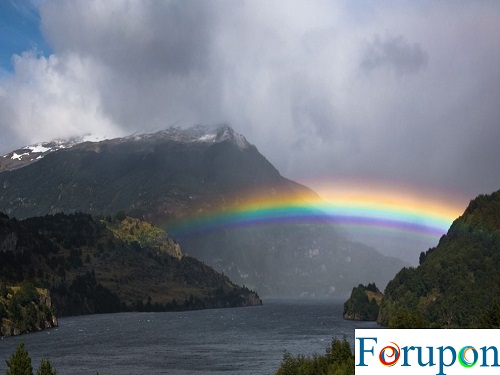Rainbow
What Colors Are Rainbows: A rainbow is a multicolored arc made of light-striking water droplets. The most familiar type of rainbow, including this one in southern Chile, is produced when sunlight strikes raindrops in front of a viewer at a precise angle. The colors on a primary rainbow are always in order of their wavelength, from longest to shortest: red, orange, yellow, green, blue, and violet.
Rainbow Optics
A rainbow is produced by a ray of light being refracted and reflected by water. Light is refracted (bent) as it enters a water droplet. It is then reflected (bounced off) the back of the droplet. As the reflected light exits, it is refracted again. The electromagnetic spectrum is made of light with many different wavelengths, and each is reflected at a different angle. Thus, the spectrum is separated, producing a rainbow.
Circular Rainbow
Rainbows are actually complete circles. Viewers on the ground are limited to rainbows above their horizon. From the air, however, viewers can occasionally see circular rainbows. Notice that the interior of a rainbow is lighter than the exterior—that’s because the colors of a rainbow overlap at their edges, bleeding into a sheen of “white” sunlight.
Rainbows
Rainbows can form anywhere moisture is suspended in the air, including splashing rivers and sea spray. A rainbow’s radius is determined by the liquid’s refractive index–the measurement of how much light refracts (bends) as it enters a new medium (from air to water). Saltwater has a higher refractive index than freshwater, so rainbows formed by saltwater have a smaller radius. What Colors Are Rainbows?
Double Rainbow
The focus of a rainbow is the antisolar point–the imaginary point exactly opposite the sun. The antisolar point in this image of Samburu National Park, Kenya, is made clear by the photographer’s (viewer’s) shadow. Look closely and you’ll see this is a double rainbow (called a second-order rainbow) made by water reflecting twice in the raindrop. The visible spectrum appears reversed in secondary rainbows–the red is on the interior arch while the violet/purple is on the exterior. In the lab, scientists have created a 200th-order rainbow.
Grand Rainbow
Supernumerary rainbows are thin, pastel-colored rainbows that sometimes appear beneath the inner arch of a primary rainbow. Some faint supernumeraries are visible in this rainbow over the Grand Canyon, Arizona. Supernumeraries are the result of the complex interaction of light rays in an air mass with small, similarly-sized water droplets.
Reflection Rainbow
A reflection rainbow, like this one over Skagit Bay, Whidbey Island, Washington, appears above a body of water.
Reflected Rainbow
A reflected rainbow appears directly on the surface of a body of water or a wet surface, like this airport tarmac. Reflected rainbows do not appear to form a circle with a primary rainbow, although their endpoints seem to meet in an almond-shaped formation.
Red Rainbow
A red rainbow, also called a monochrome rainbow, usually appears at sunrise or sunset. During this time, sunlight travels further in the atmosphere, and shorter wavelengths (blue and violet) have been scattered. Only the long-wavelength red colors are visible in this rainbow.
Fogbows
Fogbows (also called cloud bows) are similar to rainbows but lack brilliant colors because they are caused by smaller water droplets than those in a typical raincloud. This series of fogbows appeared over the National Science Foundation’s (NSF) mobile science facility (MSF) at Summit Station, Greenland.
Moonbow
A moonbow, also called a lunar rainbow, is a rainbow produced by light reflected by the Moon. This moonbow appeared over Victoria Falls, Zambia.
Noah
Rainbows are part of the myths of many cultures around the world. One of the most famous stories of the rainbow is the Biblical story of Noah, shown here in a mosaic at the Basilica of San Marco in Venice, Italy. God sent the rainbow as a symbol to never again destroy the Earth with a flood.
Wiphala
The rainbow remains a powerful symbol for communities around the world, many of whom use the rainbow flag to symbolize diversity and respect. The Wiphala, above, is a symbol of communities indigenous to the Andes Mountains, stretching from modern-day Ecuador to Chile. The Wiphala features a diagonal patchwork design with squares in different rainbow colors. Different arrangements of patchwork squares represent different Andean communities.
Colors
Rainbow Variations
Twinned Rainbow
Fogbow
Rainbows in Myth
Rainbow Flags

Somewhere, over the ocular dispersion of the electromagnetic spectrum . . .
Photograph by David Armstrong, MyShot
Rainbows Near and Far
Some scientists think rainbows also exist on Titan, one of the moons of the planet Saturn. Titan has a wet surface and humid clouds. The sun is also visible from Titan, so it has all the ingredients for rainbows.
The article was originally published here.
TO GET MORE KNOWLEDGE ABOUT What Colors Are Rainbows, PLEASE VISIT OUR SITE: Forupon.com.


Comments are closed.